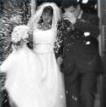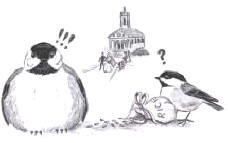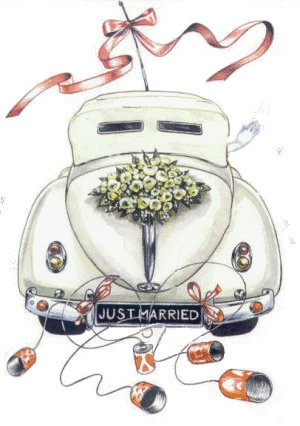|
 The Wedding Cake...
The Wedding Cake... |
 The 3-tiered cake is believed to have been inspired by the spire of
Saint Bride's Church in London, England
The 3-tiered cake is believed to have been inspired by the spire of
Saint Bride's Church in London, England |
|
Click here for more information about the Saint Bride's Church. |
| Sleeping with a piece of wedding cake
(or a piece of groom's cake) under her pillow is said to make a single
woman dream of her future husband. |
| In medieval England, guests brought
small cakes and piled them on the center of a table. The bride and groom
then attempted to kiss over them. A baker from France conceived
the idea of icing all the small cakes together in one large cake. |
| According to one long-forgotten
tradition, the bottom layer of a wedding cake represents the couple as a
family, and the top layer represents them as a couple. Each layer
in between represents a child you hope to have. |
| Cutting the
wedding cake together
symbolizes the couple's unity, a shared future, and their life together
as one. The groom traditionally places his hand over the bride's
hand as a symbol of his desire to take care of her...plus, it is good
luck if the bride's hand is the first to cut the cake. |
| After cutting the cake, the newlyweds
usually share a taste by feeding cake to each other. The ancient
Romans believed the joint partaking of the cake created a magical bond.
The sweetness symbolized the future happiness of the couple and the
grain held the promise of a fruitful union. |
| The top layer of the wedding cake is
customarily taken home and frozen by the bride and groom. They
share it in celebration of their first anniversary. It is believed
that a cake that lasts a year is the guarantee of a long marriage. |
| The Groom's Cake - Traditionally, the
Groom's Cake was a fruitcake that is said to bring fertility to the
newlyweds. It was a gift from the bride to the groom. |
| Today, there are different ways to
incorporate the Groom's Cake into the festivities. Some couples
have as the main dessert Groom's Cake at the rehearsal dinner.
Some couples have the Groom's Cake More displayed next to the wedding
cake and cut up and put into small pieces for the guests to take home. |
|
*Check out our
Wedding Cake
Charms* |
| |
|
 Toasting
The Newlyweds... Toasting
The Newlyweds... |
| In China, two goblets of honey and
wine are joined with a red ribbon - the centuries old color of love and
joy - and the couple enjoy a drink of unity. Lithuanian parents
serve the wedding couple symbols of married life - wine for joy, salt
for tears and bread for work. |
| Today, French bridal couples drink a
reception toast from an engraved silver two-handled cup, called a "coupe
de mariage." This cup is passed from generation to generation. |
| In Italy, couples still follow ancient
Roman wedding tradition by walking through their village passing out
cakes and sweets. |
| Even the word "bridal" comes from a
British toasting tradition where newlyweds-to-be drank a marriage mead
known as "bride-ale" for thirty days prior to their wedding day as part
of the festivities. |
|
*We have sterling
silver Champagne charms* |
| |
|
 The
Bouquet and Garter Toss... The
Bouquet and Garter Toss... |
| Tossing the bridal
bouquet is a custom which has it's roots in England. It
was believed the bride could pass along her good fortune
to others. In order to obtain this fortune, overzealous
guests and spectators would try to tear away pieces of
the bride's clothing and flowers. In an attempt to get
away, the bride would toss her bouquet into the crowd.
Tradition says single women who catch the bouquet will
marry next. |
| In the 14th century,
Europeans would gather around the bride and try to
remove her garter for good luck. Today, the groom has
the honor of removing the bride's garter and tossing it
to single men. |
|
Have you heard of a
Fortune
Bouquet? |
| |
|
 Jumping
The Broom... Jumping
The Broom... |
| Some newlyweds "jump
over a broom" to symbolize the beginning of a new life
together. Jumping the broom was created during
slavery, when African-Americans could not legally marry.
The couple would jump over a broom in front of their
family and friends to announce their love and commitment
to each other. It is a public declaration of the
joining of two families. |
| This wedding tradition
probably came from an old African tribal marriage ritual
of placing sticks on the ground that represented the
couple's new home. Today, jumping the broom is a
symbol of sweeping away the old, and welcoming in the
new. |
| Broom-jumping can be
performed at the wedding ceremony...just after the
minister pronounces the newlyweds husband and wife, or
at the wedding reception...just after the bridal party
enters the reception area. At some wedding
receptions, guests may participate in the ceremony by
tying ribbons around the broom before the newlywed
couple make the jump. |
| *We have sterling
silver Broom charms* |
| |
|
 Throwing Rice...
Throwing Rice... |
| Throwing rice (rice,
as well as nuts and grains, are considered to be
life-giving seeds) at the newlywed couple symbolizes
fertility. Pieces of cake are thrown in some cultures.
The word confetti has the same root as the word
confectionery in Italian and was used to describe
"sweetmeats" (sugar-coated grain and nuts). |
|
 What
about the birds? What
about the birds? |
| There is a myth that
rice is harmful to birds. This is not true
according to Cornell Lab of Ornithology. (Click
Here for more information.) If you want to
avoid tossing rice, opt for bird seed, confetti, rose
petals, bubbles, sparklers, etc. Never fear, the
symbolism remains the same! |
|
|
|
 Decorating
the Car and Playing Pranks... Decorating
the Car and Playing Pranks... |
| Noisy items were tied to the back of
the couple's carriage to scare away evil spirits. Loyal friends of the
couple would play pranks on the newlyweds in the hope evil spirits would
leave the couple alone since the couple had already been picked on.
Honking horns (more loud noise) was also believed to keep the evil
spirits away. |
 Use
old shoes... Use
old shoes... |
| Down through history, shoes have
symbolized power and authority. Egyptians would exchange sandals when
they exchanged goods, so when the father of the bride gave his daughter
to the groom, he would also give the bride’s sandals to show that she
now belonged to the groom. |
| In Anglo-Saxon times, the groom would
tap the heel of the bride’s shoe to show his authority over her. (I
prefer to think of it as the shoes representing the creation of a new
family unit.) |
|
During the Tudor period in England, people would throw shoes at the
couple in their carriage. It was considered good luck if the shoes hit.
Later, the shoes were tied to the carriage....thus, shoes tied to a car. |
| Shoes also symbolize
fertility to some (Mother Goose lived in a shoe). |
| It is also supposed to be lucky if you
get married in an old pair of shoes. |
| |
|
 The Guestbook...
The Guestbook... |
| In ancient times, the
guest book was a necessity and everyone who attended a
wedding was considered a witness. They were required to
sign the marriage document. Today for the wedding
couple, the guest book is a wonderful remembrance of
those who attended their wedding. |
|
|
|
 The
Threshold... The
Threshold... |
| There are two explanations for the
tradition of the groom carrying his bride over the threshold when
entering the home as a married couple for the first time. The first is
to protect the bride from evil spirits that were thought to be lying in
wait under the threshold. The second explanation dates back to Roman
times. Tradition dictated the new wife must enter her home through the
main door; and to avoid bad luck, she must never trip or fall - hence
the custom a bride should be carried over the threshold. |
| |
|
 The
Honeymoon... The
Honeymoon... |
| In ancient times, the Teutonic people
(German order of knights) began the practice of the honeymoon. Teutonic
weddings were only held under the full moon. After the wedding, the
couple would drink honey wine for thirty days (while the moon went
through all its phases). Therefore, the period immediately following the
wedding became known as the honeymoon. While the name has survived, the
purpose of the honeymoon changed (now we throw in a romantic get-a-way). |
| During the Renaissance, the newlywed
couple were supposed to drink Honeymead (wine mixed with honey,
cardamom, and cloves) each night for the period of "one moon". |
| |
|
Previous Page
Next Page... |







 What
about the birds?
What
about the birds?
 Use
old shoes...
Use
old shoes...

